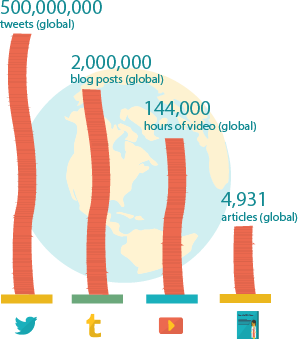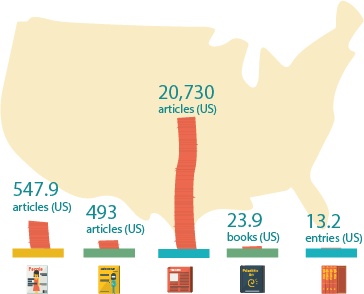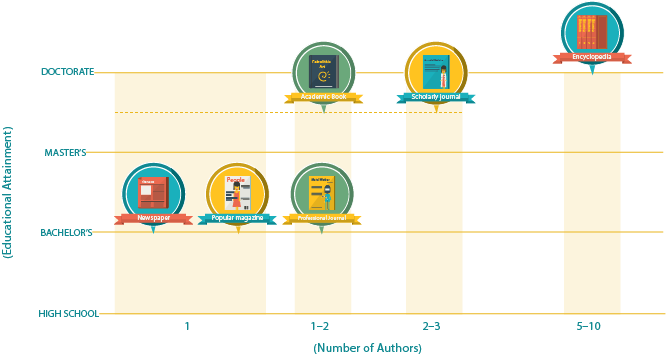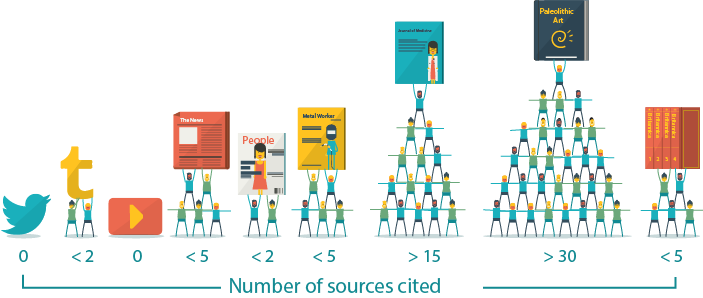14 Virtual Field Trip: Know Your Sources
KNOW YOUR SOURCES
A GUIDE TO UNDERSTANDING SOURCES
When doing research you will come across a lot of information from different types of sources. How do you decide which source to use? From tweets to newspaper articles, this tool provides a brief description of each and breaks down 6 factors of what to consider when selecting a source.
A platform for millions of very short messages on a variety of topics that enables brief dialogue between distinct groups of people across geographic, political, cultural and economic boundaries.
An avenue for sharing both developed and unpolished ideas and interests with a niche community with relative ease.
A collection of millions of educational, inspirational, eye-opening and entertaining videos that are shared rapidly and widely.
A reporting and recording of cultural and political happenings that keeps the general public informed of daily events, sports, and current news. Opinions and public commentaries can also be included.
A glossy compilation of informative, entertaining stories with unique themes intended for a specific interests—or lifestyles—from celebrities to gardening to gaming.
A collection of work-related articles that keep professionals up-to-date on the latest trends, breakthroughs and controversies in their field.
A collection of analytic reports that outline the objectives, background, methods, results and limitations of new research written for and by scholars in a niche field.
A book in which the information presented is supported by clearly identified sources. Sometimes each chapter has a different author, and the editor pulls them all together into a whole. Often these types of books have a narrow and specific focus.
A book or set of books giving information on many subjects or on many aspects of one subject. Some are intended as an entry point into research for a general audience, some provide detailed information. Most list relevant books and articles for further information on a topic.
TOTAL NUMBER PUBLISHED PER DAY
When an idea can be published quickly, we end up with many ideas that we have to sift through before we find what we’re looking for. As the selectivity of a medium increases, the value and uniqueness of the contribution typically increases too. However, on the flip side, when the selectivity increases, fewer diverse ideas or voices may be published.


DEGREE OF SCRUTINY BEFORE A SOURCE IS PUBLISHED
Two factors contribute to the amount of scrutiny that a source receives before it might be published: The number of reviewers fact-checking the written ideas and the total time spent by reviewers as they fact-check the ideas. The more people pulled into the review process and the longer the review process takes, the more credible the source is likely to be.
DEGREE OF AUTHOR EDUCATION
One factor contributing to the amount of knowledge used to produce a source is the number of authors collaborating on the article. When more people contribute their viewpoints or ideas to the writing, the quality and breadth are likely strengthened. A second factor to consider is the number of years of formal education that the author(s) received prior to writing the article. The more combined education that the authors have, the more knowledgeable we can assume the team of authors to be. What other factors can contribute to author expertise?


NUMBER OF OUTSIDE SOURCES
When an author pulls many outside sources into her writing, she demonstrates familiarity with ideas beyond her own. As more unique viewpoints are pulled into a source, it becomes more comprehensive and reliable. Below, we show the typical number of outside sources used in each publication.
 15, Academic books: >30, Encyclopedias: <5." width="703" height="298">
15, Academic books: >30, Encyclopedias: <5." width="703" height="298">AVERAGE NUMBER OF WORDS PER SOURCE
When an source uses more words to convey its points, those words are likely used to document a more thorough, well-reasoned argument that is better supported with existing research or past claims. Below, you will find the typical number of words used by an author when expressing ideas in each source.
BACKGROUND KNOWLEDGE
Every source makes some assumptions about the reader’s knowledge of the subject. The level of technical words and ideas rises when the author is targeting readers in a niche field. In advanced sources, the reader can expect the information and writing to go beyond the basics. When the author is writing for a general audience, terms are typically defined and background information is provided to make the content understandable to an average reader. Here, we convey the typical level of knowledge assumed by authors for each type of source.
DATA SOURCES
- Bosch, S. & Henderson, K. (2013, April 25). The Winds of Change: Periodicals Price Survey, 2013. The Library Journal. Accessed at http://lj.libraryjournal.com/2013/04/publishing/the-winds-of-change-periodicals-price-survey-2013/#_
- Bureau of Labor Statistics, U.S. Department of Labor (2014-15 ed.). Reporters, Correspondents, and Broadcast News Analysts. Occupational Outlook Handbook. http://www.bls.gov/ooh/media-and-communication/reporters-correspondents-and-broadcast-news-analysts.htm
- Calcagno, V., Demoinet, E., Gollner, K., Guidi, L., Ruths, D. and de Mazancourt, C. (2012, November 23). Flows of Research Manuscripts Among Scientific Journals Reveal Hidden Submission Patterns. Science: 338.
- Edmonds, R., Guskin, E., Mitchell, A. and Jurkowitz, M. (2013, May 7). The Pew Research Center’s Project for Excellence in Journalism. The State of the News Media 2013: An Annual Report on American Journalism. Newspapers: By the Numbers.
- Edwards, J. “Here’s Tumblr’s Total Revenue For 2012—And How It Will Make A Profit in 2013”. Business Insider. Retrieved March 21, 2013.
- Elsevier. Understanding the publishing process in scientific journals. http://www.elsevier.com/authors
- Griensesen, M. and Zhang, M. (2012, October 24). A Comprehensive Survey of Retracted Articles form the Scholarly Literature. Plos One. http://www.plosone.org/article/info%3Adoi%2F10.1371%2Fjournal.pone.0044118
- Hashemi, B. S. The Peer Review Process. http://www.jri.ir/Images/En/Peer_review_process.gif
- Holcomb, J. and Gottfriend, J. and Mitchell, A. (2013, November 14). News Consumption Varies Widely Across Social Networking Sites. Pew Research Journalism Project. http://www.journalism.org/2013/11/14/news-use-across-social-media-platforms/
- Luther, J. (2013, March 18). Book Review: Academic and Professional Publishing. The Scholarly Kitchen, from the Society for Scholarly publishing. Accessed at http://scholarlykitchen.sspnet.org/2013/03/18/book-review-academic-and-professional-publishing/
- Matsa, K. E., Sasseen, J. & Mitchell, E. (2012). Magazines: By the Numbers. State of the Media. http://stateofthemedia.org/2012/magazines-are-hopes-for-tablets-overdone/magazines-by-the-numbers/
- Newspaper Circulation Statistics. (2012, September 4). Newspaper Circulation of America. Newspaper Association of America. http://www.naa.org/Trends-and-Numbers/Circulation-Volume/Newspaper-Circulation-Volume.aspx
- The Pew Research Center. (2013, August 5). Spring Tracking Survey, April 17-May 19, 2013. N= 1895 adults. The Internet & American Life project. Available at http://www.pewinternet.org/2013/08/05/72-of-online-adults-are-social-networking-site-users/. Accessed 3/15/2014
- Rampton, J. Blogging Stats 2012 (2012, July 13). State of the Blogging World. Blogging.org. http://blogging.org/blog/blogging-stats-2012-infographic/
- Shafer, J. (2008, March 14). From Assembly Line to Network at the Post: The Washington Post’s Plan to drag the editing process into the 21st century. Slate. http://www.slate.com/articles/news_and_politics/press_box/2008/03/from_assembly_line_to_
network_at_the_post.2.html - Waters, D. & Meisel, J. (2007). Scholarly Publishing Initiatives: 2007 Annual Report. The Andrew Mellon Foundation. http://www.mellon.org/about/annual-reports/2007-scholarly-publishing-initiatives/
- WebWire. (2012). Trade Publications by Industry. https://www.webwire.com/IndustryList.asp

